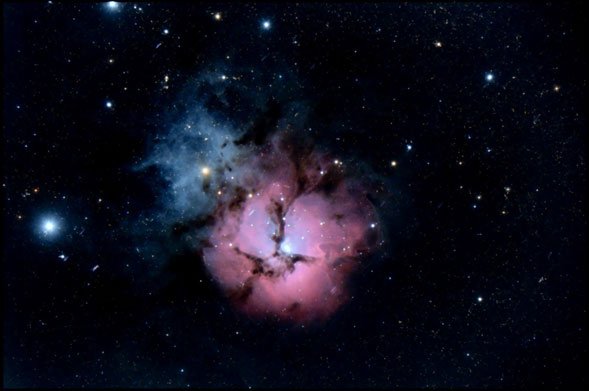This is Messier 8, the Lagoon Nebula. It’s a bright (magitude +6.0) emission nebula that’s divided by a lane of dark intersteller gas. It’s located about 4,000 lightyears away from us. M8 is believed to be an area of star formation.
Under very dark and clear skies, M8 can be observed with the naked eye. It will appear as a gray smudge just to the west and south of Saturn. Use a pair of binoculars or a telescope to bring out its color and the band of dark gas.
While you are looking for M8, you might run into M20, the Trifid Nebula. It is just to the west of Saturn and right above M8!
M20 is a combination of an emission nebula, (the red parts), a reflection nebula, (the blue parts), and a dark nebula, (the black portions that appear to divide the nebula into smaller pieces.) It’s about 5,000 lightyears away and has a visual magnitude of +6.2. It’s smaller than M8, so you will probably have a difficult time trying to find it with your naked eye, but it is very easy to view with good binoculars or a small telescope. If you’re a Star Trek fan, you have probably seen images of M20 in some of the episodes.
What to look for in September 2018.
Just like August, September starts with Venus, Jupiter, Saturn and Mars all visible and forming an arc across the evening sky! That arc is called the Ecliptic. The Ecliptic is the plane the planets follow as they orbit around the sun.
September features some very major nebula action. In addition to the Trifid and Lagoon Nebula (M8), the Eagle (M16) and Omega (M17) nebulae are also visible slightly higher in that same band of the Milky Way. All four nebulae are bright objects that you should be able to see with a decent pair of binoculars.
In the middle of the sky, you can find M27 and M57, the Dumbbell and Ring Nebulae. To the north, there are a great collection of nebulae, including the North American Nebula, the Veil Nebula, and the Elephant Trunk Nebula.
September does not have any major meteor showers.
Moon Phases:



